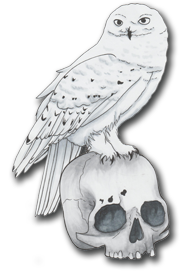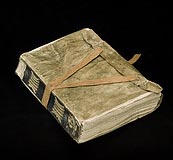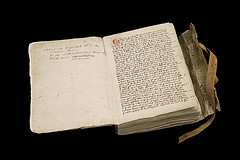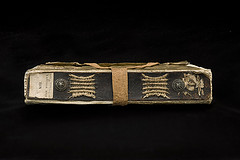Leatherbound Journal
What can I say, I wanted a different way to lug around my documentation.
Project Completed February, 2014
Inspiration Point and Reasoning
Ok, so I was looking at these pictures from The National Library of Sweden. Why? Because they have some gorgeous photos of the pieces in their collection. Most of them were extrordinarily intricate, hard bound volumes. I'd wanted a way to display some of the materials that I've put together into a book format to take around with my A&S entries, but to be honest a hand made and bound hard cover volume is quite an involved bit of work. As I was poking around though, I came across an example of a "limp vellum" bound book. I'm putting a couple images of the source material here, but credit goes to the Museum.
What struck me as wonderful about this example is that it looks as though the pages are stitched right into the spine, instead of to a secondary meduim prior to binding. I'd never heard the term "vellum" before, so I dug it up briefly on Wikipedia and sure enough it said that was its own style of binding using calf skin! Not only did they bind using leather, but they also were able to create a type of parchment from calf skin as well! Pardon the excitement, I had no idea.
At any rate, from what I am able to see in the source example, the pages were stitched through the strip of leather on the binding, then around strips of medium before going back into the book. In hard bound examples that I'd looked over in the past, the technique would have been closer to stitching straight through the secondary medium (thin cloth, etc) and directly back into the next hole in the page. the source example seemed less like sewing than it did stitching using knots around the strips of medium or cord, so I though that was a pretty cool difference as well.
Concept
The concept was probably the easiest part of the process. I needed something to tote around my notes in, and I wanted it to look nicer than a normal 3-ring binder. Secondarily, I've had a beautiful cut of "kodiak" oil tanned leather from Tandy that had been sitting in my rack for a while. The nice thing about the leather is that if you scrunch it up into a ball, the oils sway from the creased points to give it a nice weathered look. If you want to restore or change it to a different pattern, you just rub on it for a moment with your hand, then crumple it up again for a new pattern. It almost looks like Indiana Jones' jacket in a way, but I digress.
Implementation
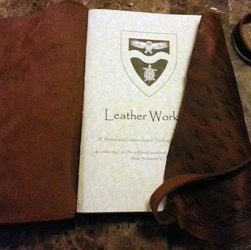



I chose a papyrus paper for the actual pages in the book. It's a little heavier weight than what the source material appeared to be at 24 lbs, but I liked the look and feel of the paper. After a little reading on book binding, I decided to have my signatures be 4 full sheets of the paper halved, so each signature was 8 pages. Next, I printed my notes on the paper with my home printer. I wasn't altogether thrilled at the print quality of the pages, but it added to the worn and torn look and feel that I was going for. After the pages were put gathered and sorted into their signatures, I also weathered the corners a bit by using a combination of a wood burner and sand paper. I gave just enough distressing in the process that it lightly discolored and frayed the edges.
I decided that I wanted an odd cover, so I cut the overall dimensions into the edge of the hide. This gave me a natural diagonal bend to overlap the front cover with. I was rather pleased that the coverage was different from a straight edged cap to it. I then measured and punched a set of four holes in the top, middle and bottom of the cover. To stitch the signatures to the cover, I deviated from the source and stitched directly onto the hide. For each signature, it became a process of looping through the holes that I'd punched, then back in to the next measured hole in the signature. Where I liked the knotting of the binding within the source, I wanted to keep the look of the piece of leather intact, instead of having larger balling of knots and string on the spine. I tried to keep each signature as tightly pressed to the one prior to it as possible to keep from varying the height of the pages once the book was finished, but it did leave me with some variance by doing so. It also caused a bit of natural lean or slant when the pages were together, which was relatively easy to correct once it was closed.
To tie off the journal, I cut a strap of the hide. I cut a slit in the length at one end as well so that I could tie it to the cover directly using something of a modified "lark's head" knot. Doing so kept the strap intact well enough that I could simply wrap the strap around and tuck it through itself to keep the journal closed.
Once I had gotten the piece together, I also had a wild hair to decorate it in some fashion. Since oil tanned leather will not hold tooling, I thought I would test out my wood burner on the leather. I was quite surprised (and pleased) to see how easily and fluidly the burner worked with the oil in the leather. Now whether or not it was healthy and/or safe? I'm sure it's a negative response in both directions. I used the beveled tip for the burner to mark out knotwork corners, then the fountain pen looking tip for doing the feather-like patterned spaces in the void. I also utilized the wood burner's stylus tip to sign the journal underneath the overlapping flap. The result was that no matter how many times I changed the patterning by scrunching the leather, the burned areas stayed intact.
After Thoughts
In retrospect, I think I would rather not print out pages again, even though it gave a rather finished look to it. I think I also would attempt to tea or coffee stain thinner weight paper in the future as well. I love the parchment, but the pages feel too thick inside of the application itself. There have been many times that I've wanted to make entries into the journal, but felt like it would ruin the flow. I've left space at the back of the journal for folks to leave their own notes in as well, but it's gone unused, presumably because people don't feel comfortable writing in someone else's book. I may make a second attempt at a later date, especially as I delve into my more scientific natured projects coming up with period dye creation and technique and couir boulli notes.
For the burner, I've tried on non-oil tanned leather without being able to replicate the result effectively. I think that I will keep the application to oil only, when I have requests (or wild hairs) to spice those up. Otherwise, the wood burner will stay put away.
I believe I'll aslo do a bit more study and research on period binding techniques.
Constructive feedback is both welcome and appreciated, please let me know if I missed some pertinent information or if there's somewhere I can improve.
As always, thanks for reading!
Ihone
